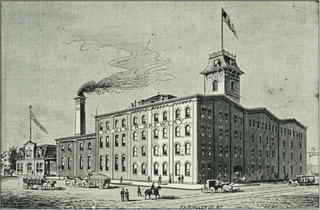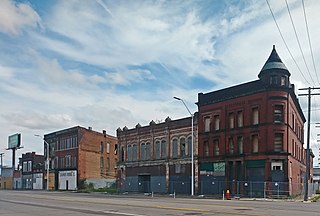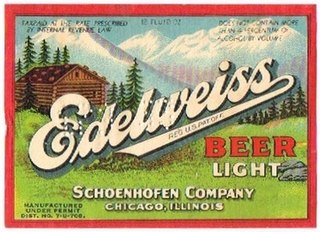Green River is a bright green, lime-flavored soft drink. It was created by Richard C. Jones in Davenport, Iowa, sold widely by the Chicago-based Schoenhofen Edelweiss Brewing Company in 1919, subsequently sold by other vendors, and is currently manufactured by Sprecher Brewery.

Lower West Side is a community area on the West Side of Chicago, Illinois, United States. It is three miles southwest of the Chicago Loop and its main neighborhood is Pilsen. The Heart of Chicago is a neighborhood in the southwest corner of the Lower West Side.

The Olympia Brewing Company was a brewery in the northwest United States, located in Tumwater, Washington, near Olympia. Founded in 1896 by Leopold Friederich Schmidt, it was bought by G. Heileman Brewing Company in 1983. Through a series of consolidations, it was acquired by Pabst Brewing Company in 1999; the Tumwater brewery was closed in 2003.

The Lembeck and Betz Eagle Brewing Company was founded in 1869 by Henry B. Lembeck and John F. Betz in Jersey City, in Hudson County, New Jersey, United States. The brewery, bounded by 9th, 10th, Grove, and Henderson streets in downtown Jersey City, developed into one of the most famous, best-equipped, and financially successful breweries on the East Coast of the United States.

The Great Atlantic and Pacific Tea Company Warehouse is a historic formerly commercial building at 150 Bay Street in Jersey City, Hudson County, New Jersey, United States. Built as a warehouse for The Great Atlantic & Pacific Tea Company (A&P) in 1900, it is the major surviving remnant of a five-building complex of the nation's first major grocery store chain. It was designated a National Historic Landmark in 1978, and now houses a mix of residences and storage facilities.

The Tivoli Brewery is a historic building originally home to the Tivoli Brewing Company. It was designed by prominent Denver architect Frederick C. Eberley. The building is located in the Auraria Neighborhood of Denver, Colorado. Today the building is home to the Tivoli Student Union of the Auraria Campus, serving as a student center for the Metropolitan State University of Denver, Community College of Denver, and the University of Colorado Denver. In August 2015 the revived Tivoli Brewing Company began brewing in a new facility inside the building, in the original brewing area.

The Randolph Street Commercial Buildings Historic District is a historic district located in Downtown Detroit, Michigan, which includes six buildings along Randolph Street between Monroe and Macomb streets. The district was listed on the National Register of Historic Places in 1980. The collection of buildings are a rare surviving set of Detroit Victorian-era commercial structures. The Randolph Street Commercial Building Historic District joins the Broadway Avenue Historic District downtown.

The Gerald W. Heaney Federal Building, United States Courthouse and Custom House in Duluth, Minnesota is a courthouse of the United States District Court for the District of Minnesota. Completed in 1930, it is part of the Duluth Civic Center Historic District, listed on the National Register of Historic Places in 1986. In 2007 the United States Congress passed an act to rename the building for former Circuit Court judge Gerald Heaney. It was enacted into law that same year.

The Mather Inn is a hotel in Ishpeming, Michigan. The inn served as housing for the cast of the classic 1959 movie Anatomy of a Murder, and was the place where Duke Ellington composed the movie's score. It was designated a Michigan State Historic Site in 1976 and listed on the National Register of Historic Places in 1978.

The High Street Historic District of Hartford, Connecticut is a 1.1-acre (0.45 ha) historic district that includes three buildings typifying the architectural styles of the late 19th and early 20th centuries in the city. It was listed on the National Register of Historic Places in 1998. The buildings are located at 402-418 Asylum Street, 28 High Street, and 175-189 Allyn Street, and includes the Batterson Block and Judd and Root Building, each individually listed for their architecture.

The Zoller Bros-Independent Malting Co. building is located on the edge of an industrial area in the west end of Davenport, Iowa, United States. It has been listed on the National Register of Historic Places since 1983.

Littig Brothers/Mengel & Klindt/Eagle Brewery is located in a residential and light industrial area of the west end of Davenport, Iowa, United States. It has been listed on the National Register of Historic Places since 1983.

The William Ulmer Brewery is a brewery complex in Bushwick, Brooklyn, New York City. It consists of four buildings—an office, a brew house, an engine–machine house, and a stable–storage house—all constructed between 1872 and 1890 in the German round-arch style. The site is bounded by Belvidere Street to the southeast, Beaver Street to the northeast, and Locust Street to the northwest, with the address 31 Belvidere Street. The main brew house, the engine–machine house, and the office building were designed by Brooklyn architect Theobald Engelhardt, while the stable–storage house was designed by Frederick Wunder.
The Mink Building is a five-story German-American style red brick structure at 1361-1369 Amsterdam Avenue between 126th and 128th Streets, in the Manhattanville neighborhood of Manhattan, New York City, originally part of a large brewery complex. It is one of a few buildings that remain of a vast beer brewing industry in this area in the late 19th century, beer brewing was an industry as big as finance or real estate in the 21st century New York City. The site of the complex at 1361 Amsterdam Avenue in Manhattan - predating residential development in Harlem - was chosen due to its relative isolation at the time.

The Schoenhofen Pyramid Mausoleum is a tomb in Graceland Cemetery, Chicago. It was designed by Chicago School architect Richard E. Schmidt as a family mausoleum for the Chicago brewer Peter Schoenhofen.

The Ithaca Downtown Historic District is a commercial historic district located on East Center Street, between Main and Pine River, in Ithaca, Michigan. It was listed on the National Register of Historic Places in 2005.

The Northern Brewery is a former industrial building located at 1327 Jones Drive in Ann Arbor, Michigan. It was listed on the National Register of Historic Places in 1979.

The Best Brewing Company of Chicago Building is a historic brewery building at 1315-1317 W. Fletcher Street in the Lakeview neighborhood of Chicago, Illinois. The building was built in 1893 for the Best Brewing Company of Chicago, replacing a smaller 1885 brewery on the site that the company had bought in 1891. The company, which was founded by the Hasterlik family, was one of many German-owned breweries in Chicago at the time. Architect Oscar Beyer designed the building, which features decorative brickwork, arched windows, and a cornice. The company brewed beer at the plant until Prohibition, when it switched to other goods such as ice and malt syrup. After Prohibition ended, the company began brewing beer again, and it brought innovations to the Chicago market such as canned beer and private labels for the chain stores it sold to. While the company was bought out by the Metropolis Brewing Company of New York City in 1950, beer was brewed at the plant until 1961.

The Michigan Avenue Historic Commercial District is a group of commercial buildings located along the south side of two blocks of Michigan Avenue, from 3301–3461, in Detroit. This section of buildings is the most intact collection along this stretch of Michigan Avenue. The district was listed on the National Register of Historic Places in 2020.

The Peter Schoenhofen Brewing Company was an American brewery established in 1861 by Peter Schoenhofen and Matheus Gottfried in the Pilsen neighborhood of Chicago, Illinois. The company is notable for producing and selling the popular Edelweiss brand of American beer and the Green River brand soft drink.


















